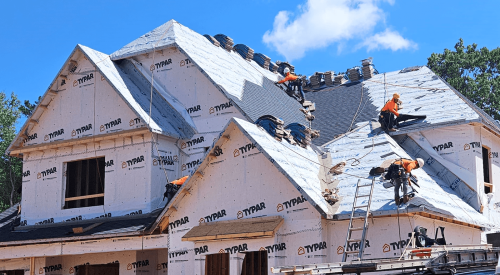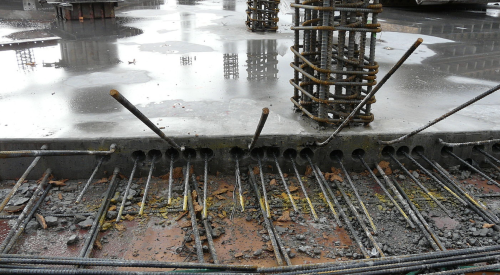The first thing a real-estate agent will tell home buyers is "location, location, location." Location should be the first thing on a builder's mind, too, when it comes to choosing the correct roofing materials.
 |
Builders need to look no further than last years' devastating hurricanes to see they must prepare for the elements — and a home's first line of defense is a solid roof. Builders must find a balance between cost-effectiveness and functionality. Spanish tiles are lovely, but they're not going to put up much of a fight against a Category 4 hurricane or a Kansas twister. On the other hand, a shingled roof with a low slope isn't going to stand up well in mountainous areas after the first big snow.
According to the Partnership for Advancing Technology in Housing, builders should take several steps to prevent a roof from failing, especially in hurricane-prone areas. PATH recommends moderately pitched hipped rather than gabled roofs to better withstand strong winds, hurricane straps, baffled ridges and soffit vents, among other precautions, to minimize roof penetrations and water damage.
 Asphalt shingles are a good all-around performer, but they may not be the best choice in all cases. |
Builders will call asphalt shingles the most popular type of residential roof material for several reasons. "We use composition asphalt shingles. They are just less expensive to us and last long. You get more for your money," says Richard Huffman, president of Huffman Homes in Austin, Texas.
Asphalt shingles are relatively inexpensive and can be bought in large quantities. They are generally very easy to install, even in situations involving steep slopes and inclement weather. They come in two basic types, glass fiber and organic; are available in a variety of colors and styles; and are fairly durable and impact-resistant. Homeowners can maintain and repair the shingles in most situations.
Organic shingles, saturated with asphalt to make them waterproof, have approximately 40 percent more asphalt per square foot than their glass fiber counterparts, which makes them more durable. However, the more popular variety is the glass fiber, which uses asphalt and mineral fillers, making them cheaper and easier to manufacture than organic shingles and more cost-effective to builders.
Asphalt does have serious drawbacks. The lifespan of asphalt shingles depends highly upon the environment. Shingles in cooler climates such as the northern United States seem to last longer than those installed in the warmer climates. Thermal shock, or rapidly changing ambient temperatures (like hot days and cold nights in the Southwestern U.S.) greatly affect the lifespan of asphalt roofs. The materials can't expand and contract to accommodate such a dramatic temperature change in such a short period of time, and cracks and splits are bound to occur, allowing water to seep in. Many roofing contractors and consultants that use asphalt advocate steeply-sloped roofs to shed water and reduce the possibility of water damage. "Asphalt is great, but it's just not amenable to rainwater," Huffman adds.
Still another factor affecting asphalt shingle roofs is attic ventilation. Proper roof ventilation extends the life of the roof and helps maintain heating and cooling costs. That's where tiles, such as Spanish-style, metal, clay and wood or wood-substitute shakes come in because they allow ventilation.
Especially popular recently are cedar shake roofs, which have twice the insulating value of standard asphalt shingles. Hail does not easily damage cedar shakes. When treated with certain chemicals, cedar shakes can be made permanently fire resistant. And unlike popular misconceptions, (especially with home buyers) when installed properly, they are extremely wind resistant.
Cedar shake roofs do require regular maintenance to maximize their useful life. Particularly harmful are sunlight and rainfall. Cedar shakes are treated with chemicals called extractives to preserve the wood and prevent mold and fungus. However, rainfall can leach these chemicals from the cedar shakes in less than 10 years.
UV rays actually cause the surface cells of the cedar to break down. This microscopic refuse is washed away with each rainfall. UV rays also cause very tiny cracks to develop, which allow water to drive deeper into the shakes. This accelerates the process of dissolving the extractive chemicals. To keep shakes from breaking down, they must be free of moss, fungus and tree debris. This often means calling a tree company to cut away branches from over the roof to provide proper air circulation.
Because of the relatively hefty introductory cost of real cedar shakes, many roofing manufacturers such as CertainTeed, Alcoa and Napco make materials that look like the real thing.
Stick With a Performer?Though they represent a huge share in the game, shingles and shakes aren't the only players. While cedar shakes have become in vogue, the old-fashioned built-up roof is still sticking around. Built-up roofing — first known as composition roofing when it became popular back in the 1840s — is still one of the most reliable methods of installing a new roof. A built-up roof usually comprises either asphalt or tar and has a waterproofing layer, a reinforcing material and then a surfacing layer.
The materials used in a built-up roof generally consist of bitumen-saturated felt, coated felt, polyester felt or other fabrics. The materials facing the elements are normally asphalt-based, aggregates (gravel or slag), emulsions or a granule-surfaced cap sheet. Builders differ on what techniques are most effective, but geography and personal preferences normally dictate which materials will be used in the process. The base sheets are generally asphalt-based and either organic or glass fiber. Though they have been used for generations and are sturdy, durable and effective, built-up roofs have high amounts of odor and are more time consuming to put together than asphalt shingles.
Do you go with a good all-around performer such as asphalt tiles, use a hardy built-up roof or step it up with cedar? Weigh your options carefully. Though they aren't the only things to consider, never forget the big three: climate, slope and cost.









